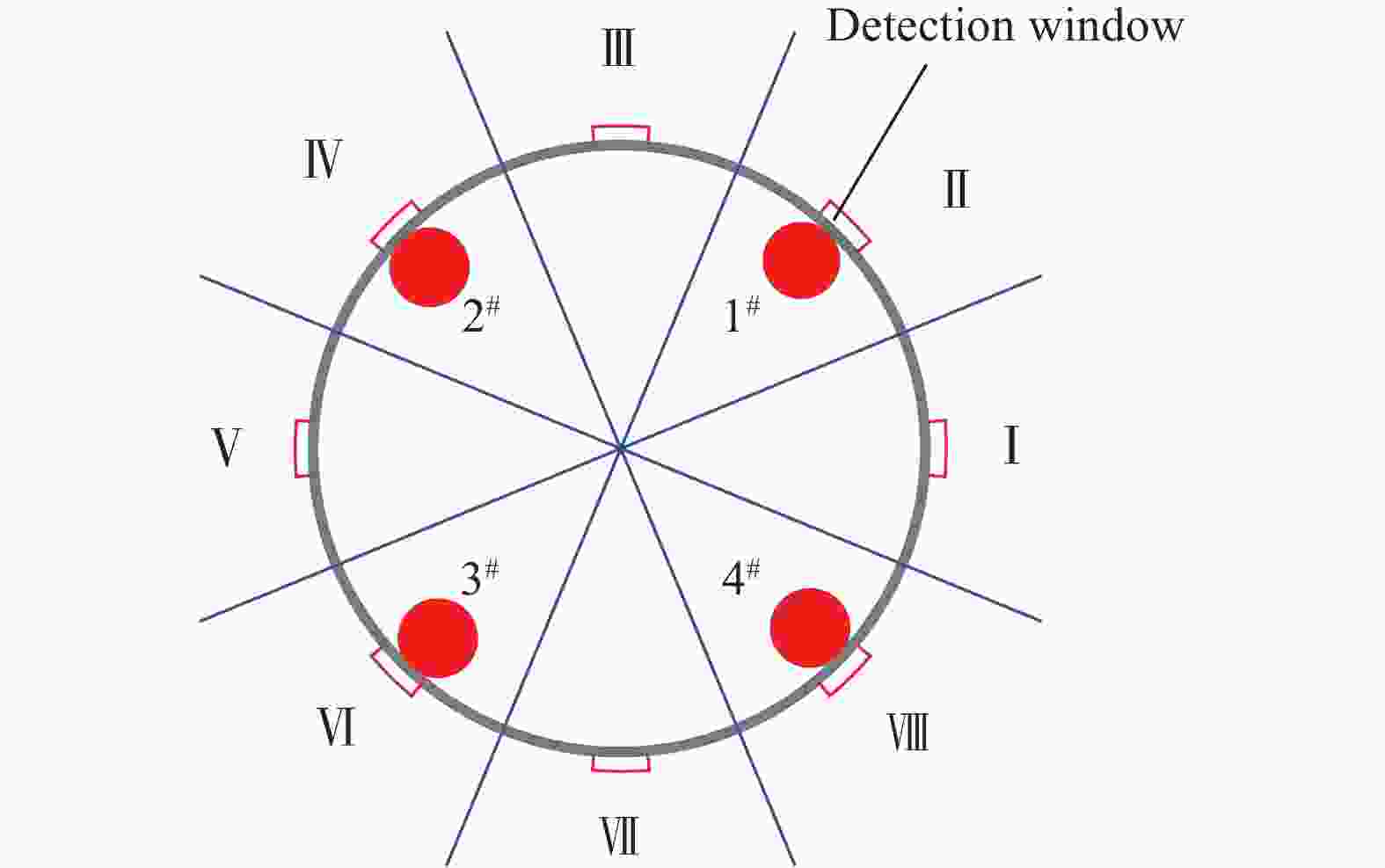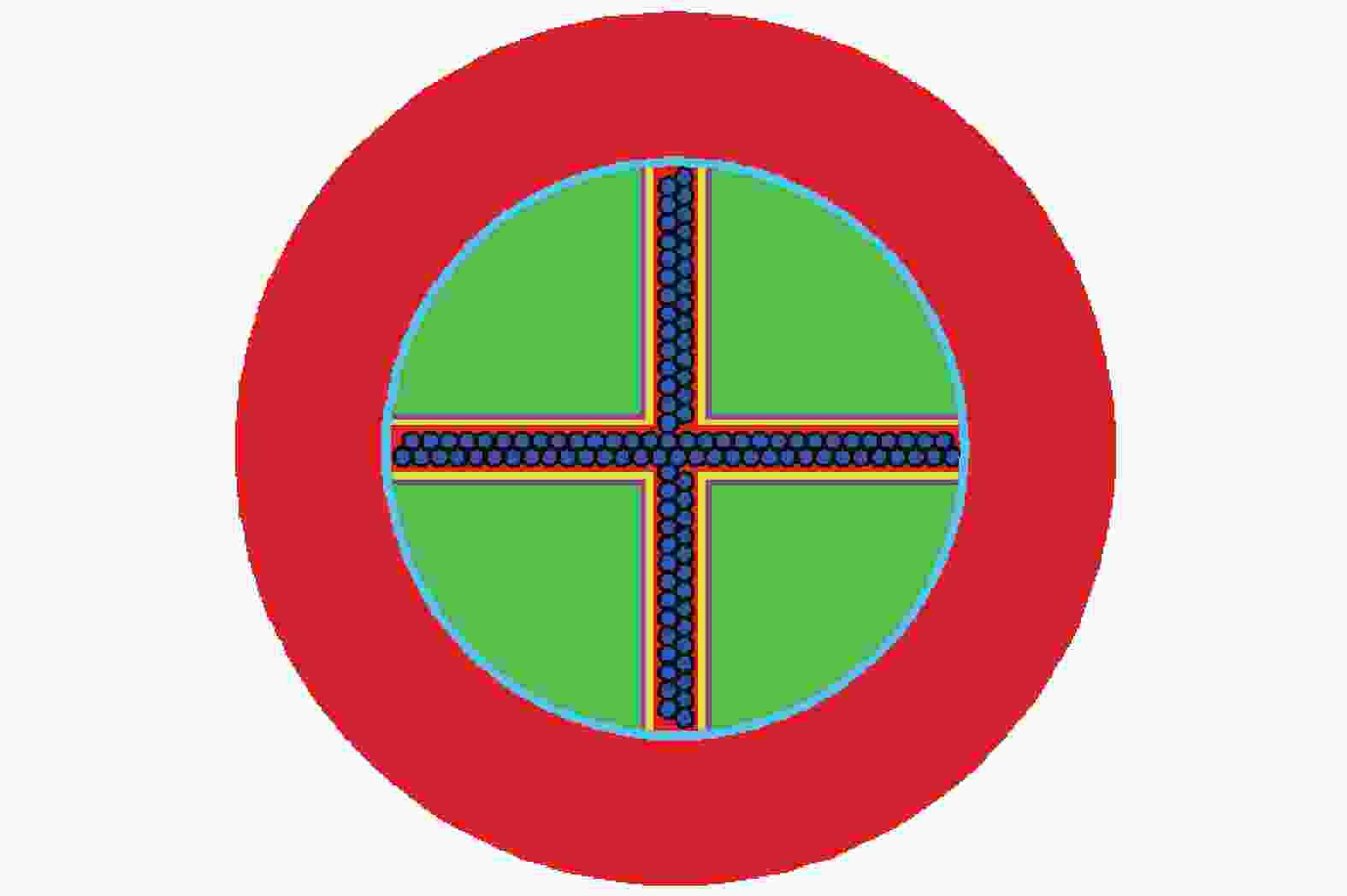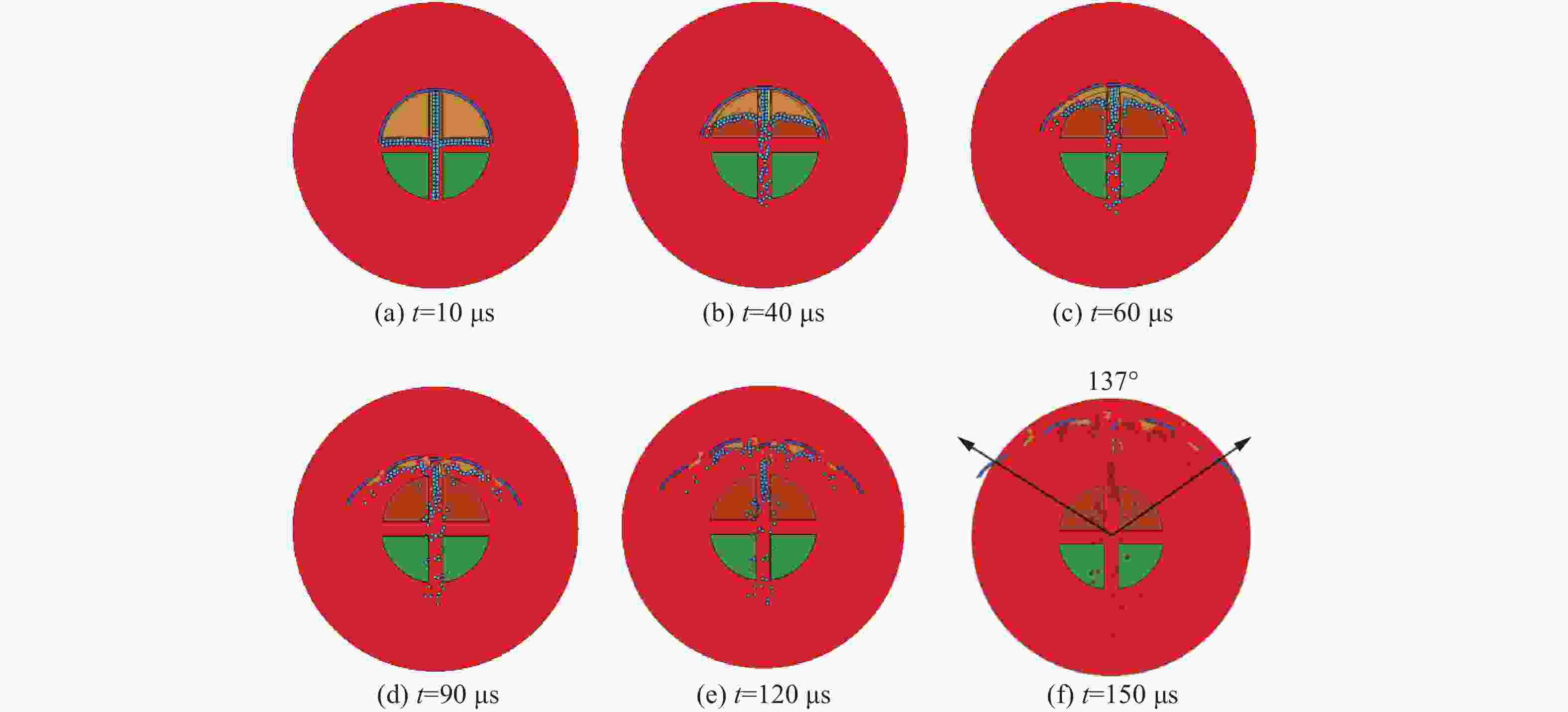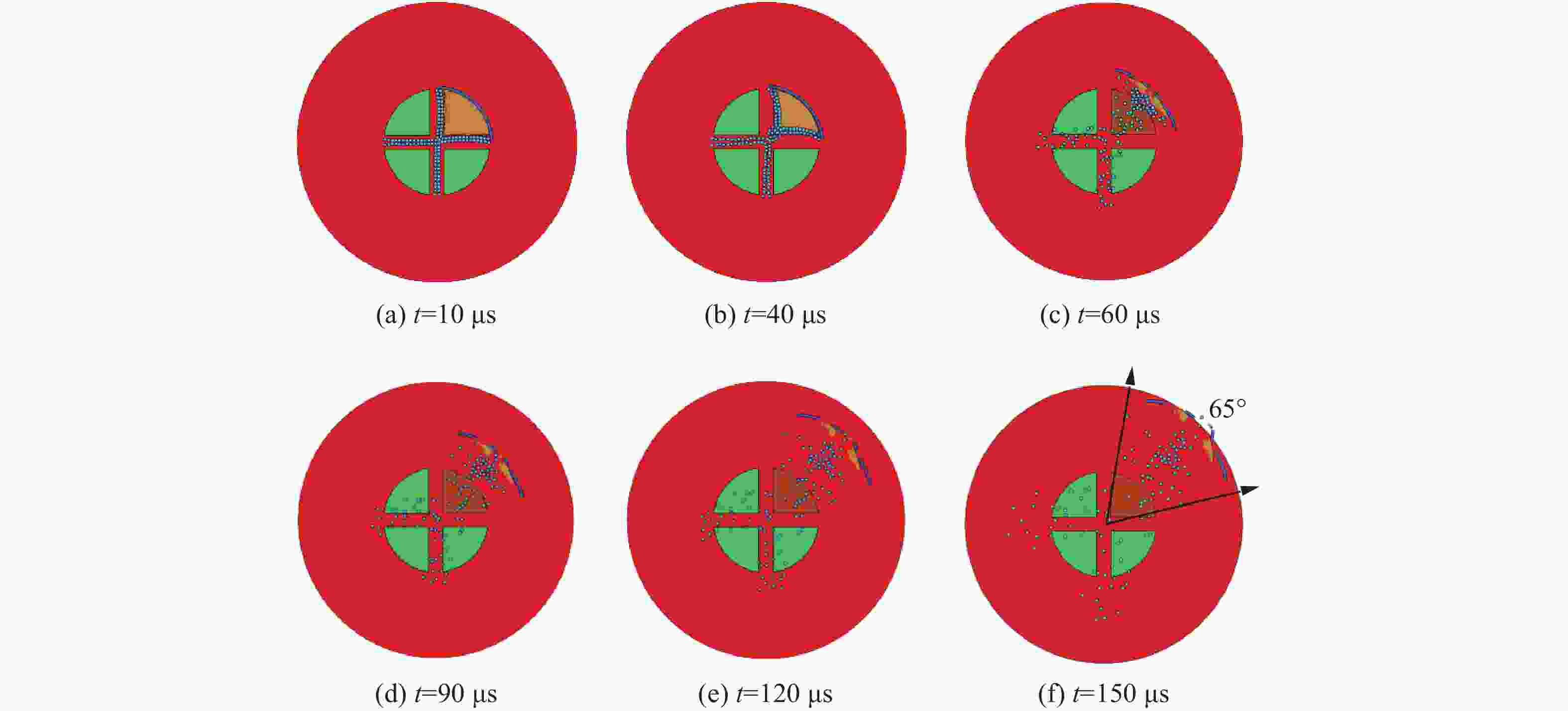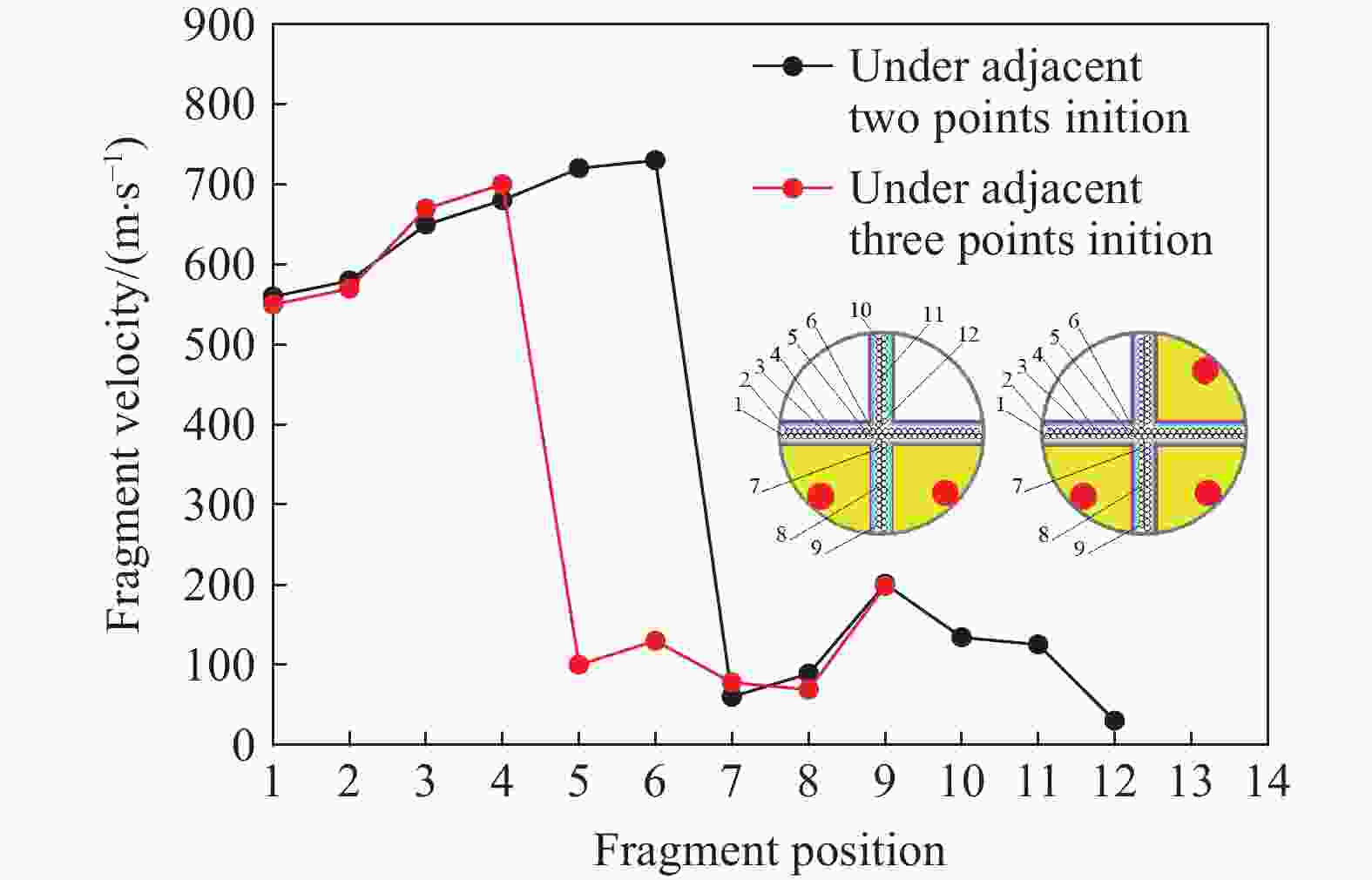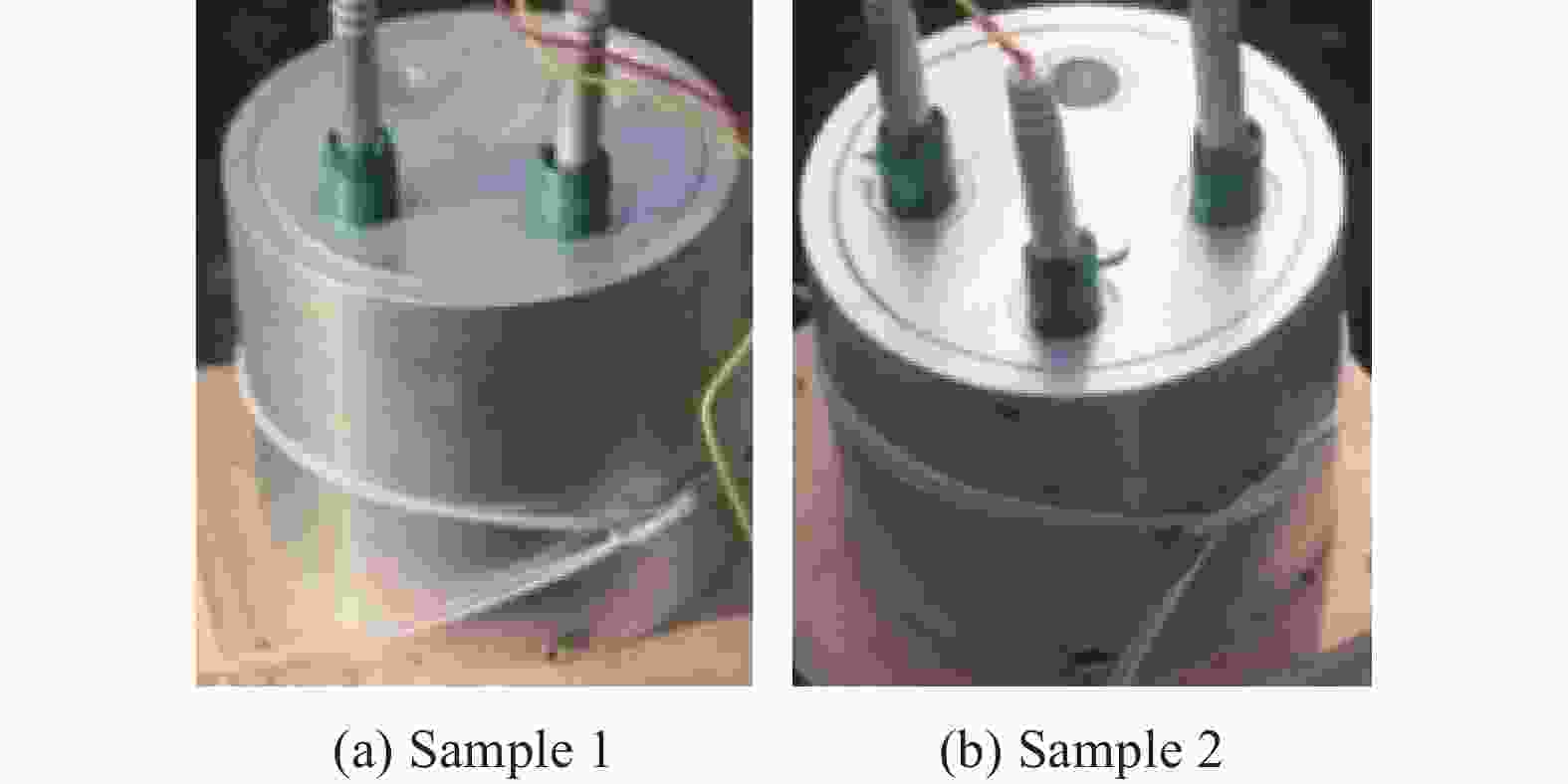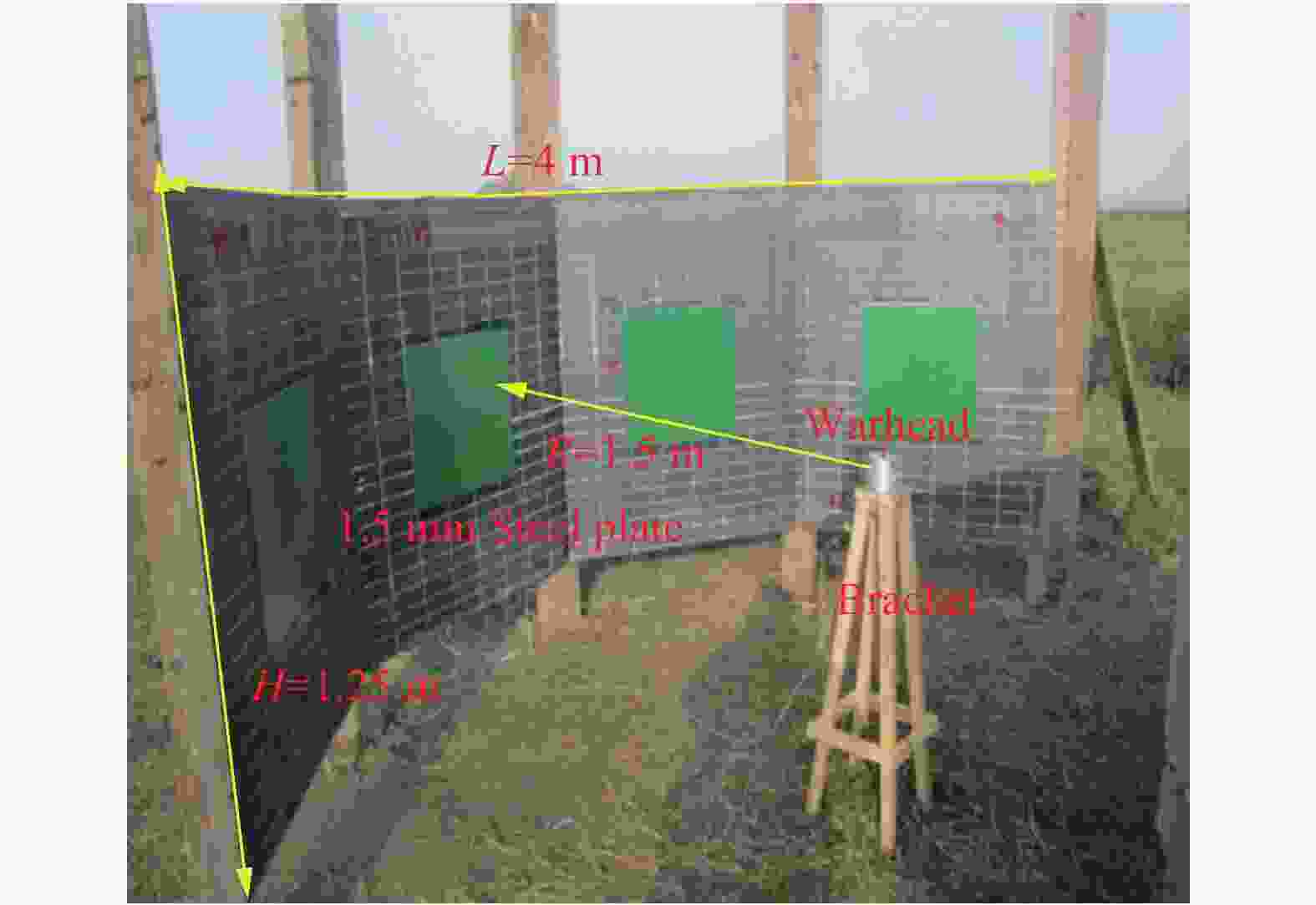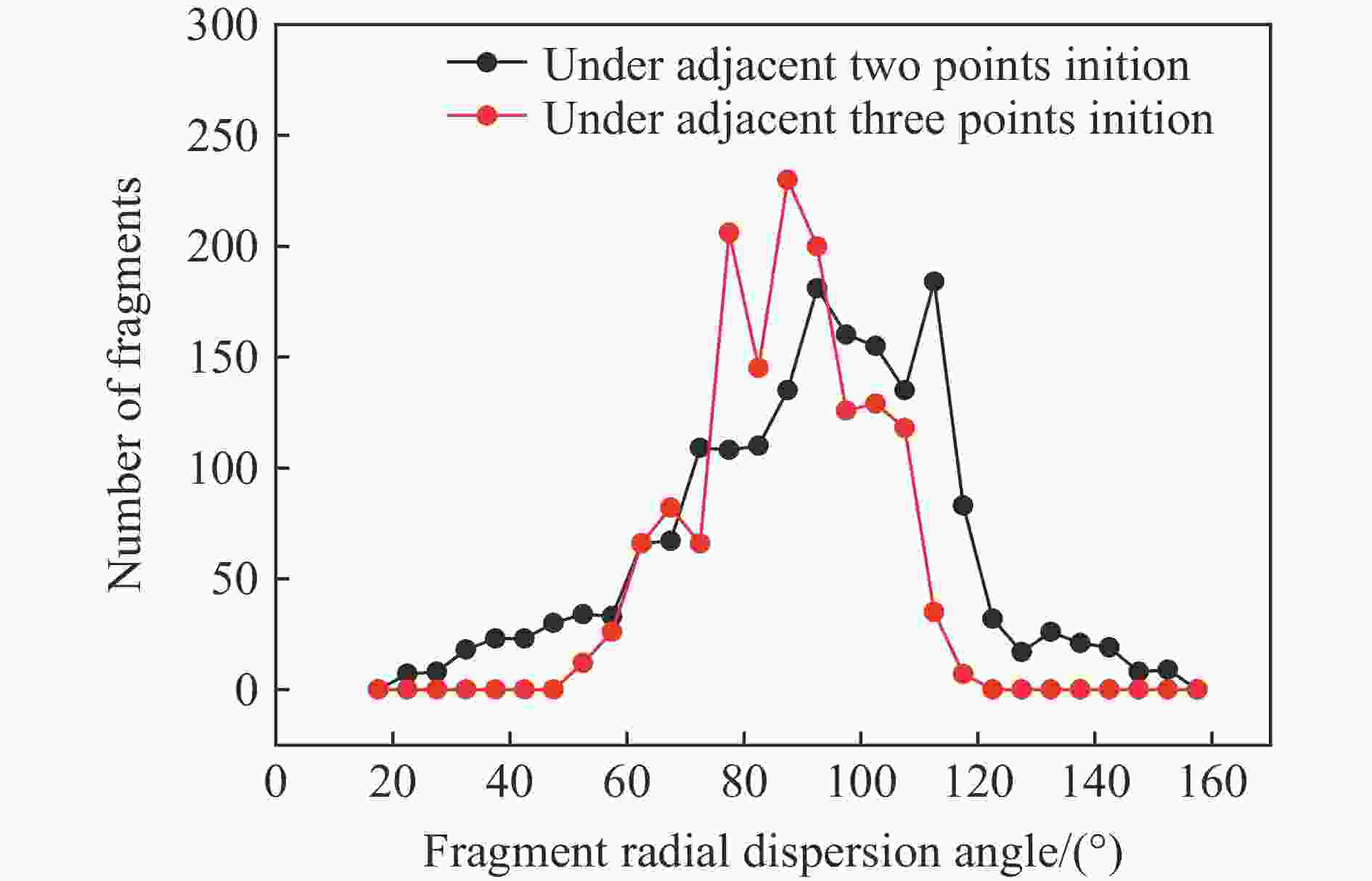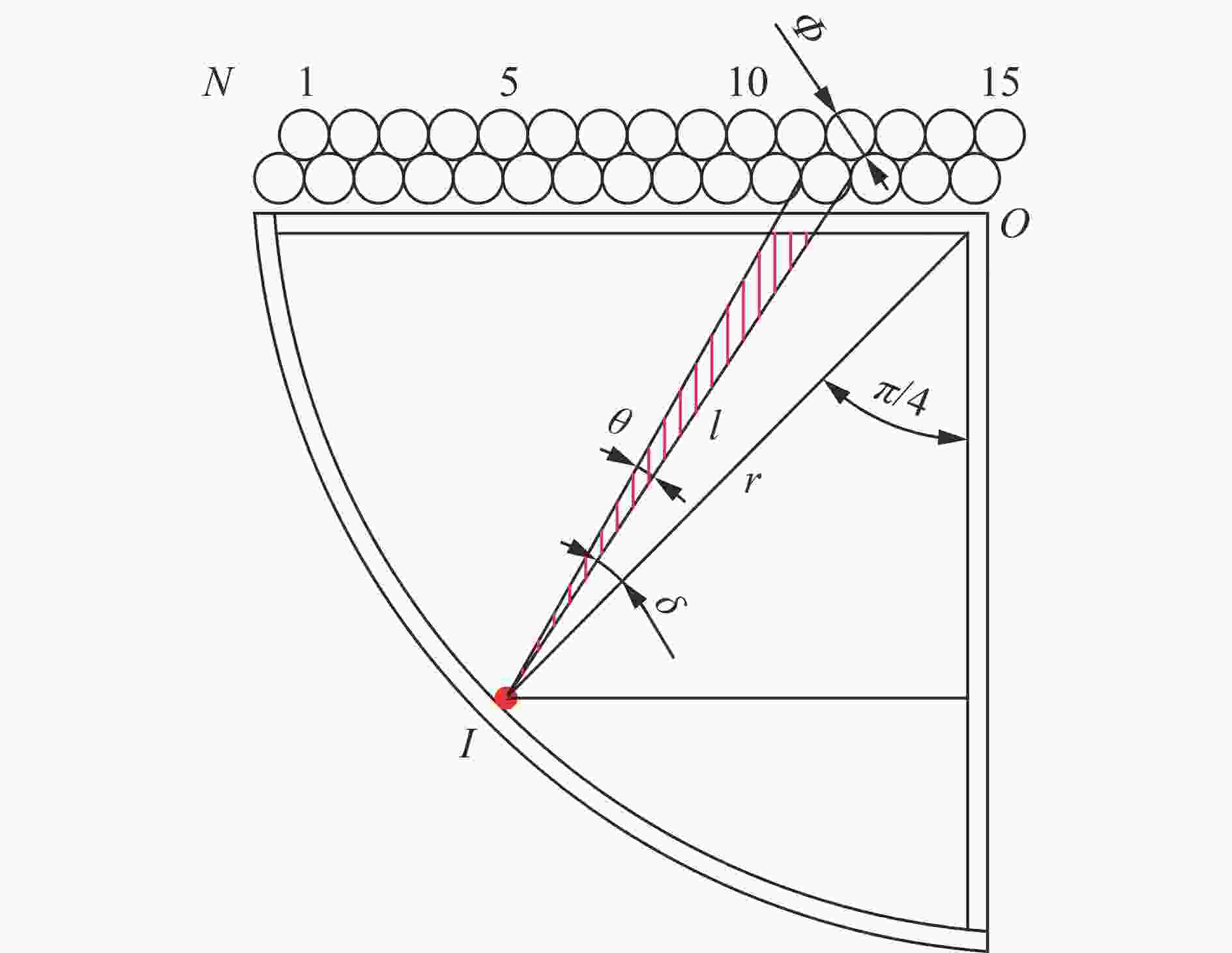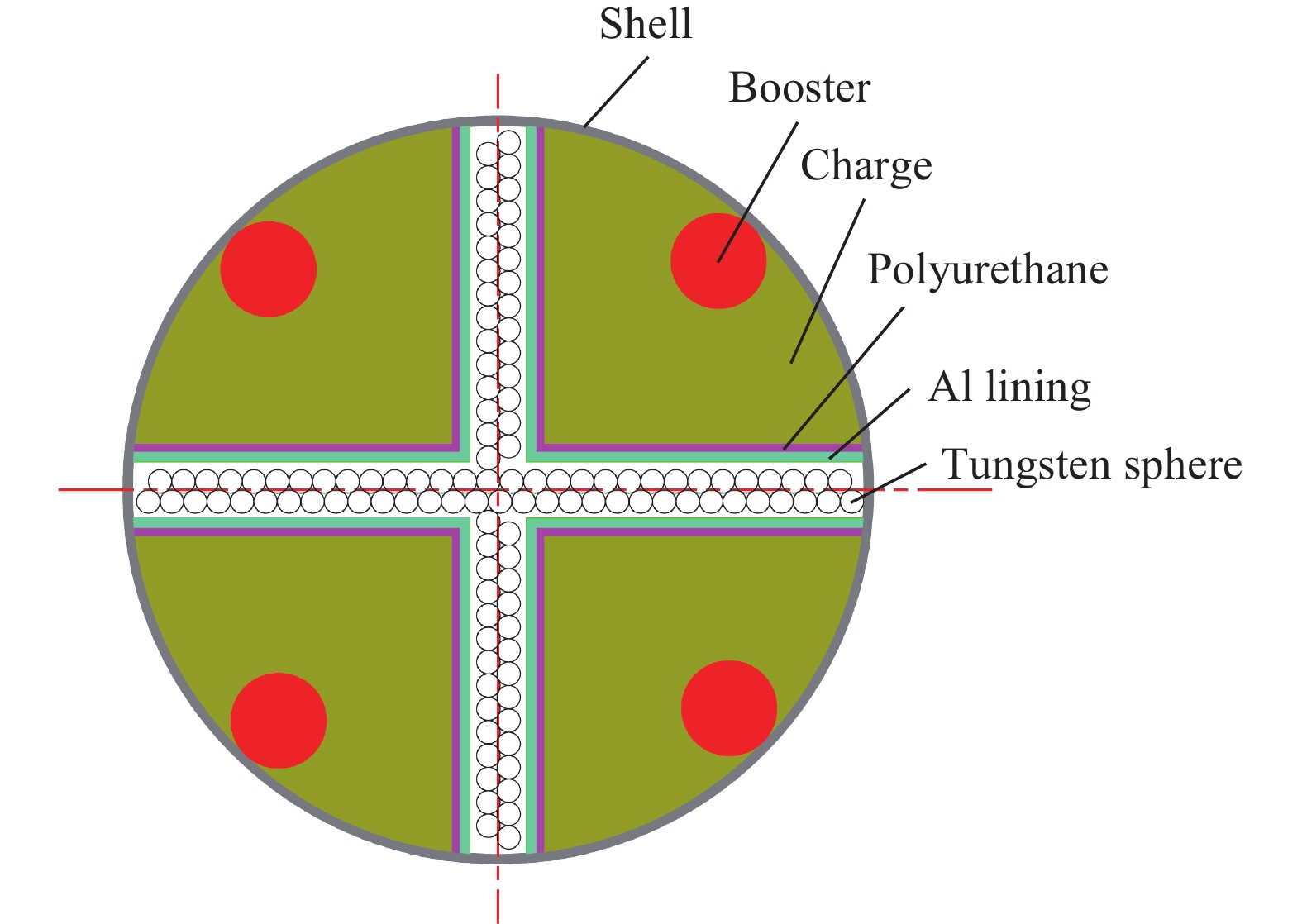Fragment dispersion characteristics of the cross-shape built-in fragmentation directional warhead
-
摘要: 针对低附带弹药毁伤需求,设计了一种十字形内置破片定向战斗部,根据目标方位可选择不同起爆模式,进而控制破片的径向飞散特性,在目标区域内形成杀伤破片实现定向毁伤,在非目标区域内实现低附带毁伤。采用数值模拟研究了相邻2点起爆、相邻3点起爆两种模式下定向战斗部起爆时破片的驱动过程,给出了各个位置处破片的飞散速度、径向飞散角度等特征参数;制备了2发单元样弹并开展了地面静爆实验,通过高速摄影及靶板上破片的穿孔分布特征实测出破片的速度及径向飞散角,与数值模拟结果对比,验证了模拟的准确性。在此基础上,通过引入能量分配角建立了破片速度的修正公式,并根据模拟结果对公式参数进行了拟合分析。结果表明:相邻2点起爆、相邻3点起爆模式下,战斗部定向杀伤区破片径向飞散角分别控制在145°、65°以内,且该区域内的破片占破片总数的比例分别达到了50.4%、43%;同时,破片速度呈现梯次分布,介于535~770 m/s之间,对1.5 mm厚的Q235A钢板的穿甲率分别达到了94.4%、84.6%,可实现对轻型车辆类目标的毁伤,其余区域则为低附带安全区;基于能量分配模型求得的破片速度理论计算值与模拟值基本吻合。研究结果可为低附带杀伤战斗部研制提供新的设计思路。Abstract: In order to meet the demand of low collateral damage, a cross-shape built-in fragmentation directional warhead was invented, which can select different detonation modes according to the target orientation and then control the radial dispersion characteristics of the fragmentation, in which the formation of anti-personnel fragmentation in the target area to achieve directional damage, while in the non-target area to achieve low collateral damage. Numerical simulation was used to study the fragmentation driving process during the detonation of the directional warhead in two modes: adjacent two-point detonation and adjacent three-point detonation. The characteristic parameters such as fragment dispersion velocity and radial dispersion angle were given at each position. Then, two principle samples were prepared and ground static explosion tests were conducted. The fragment velocity and radial dispersion angle were measured through high-speed photography and the distribution characteristics of fragment perforation on the target plate. The accuracy of the simulation is verified by comparing with the numerical simulation results, based on which the fragmentation velocity correction formula is established by introducing the energy distribution angle, and the parameters of the formula are fitted and analyzed according to the simulation results. The results show that the radial dispersion angle of fragments in the directed killing zone is controlled within 145° and 65° under adjacent two-point initiation and adjacent three-point initiation modes respectively, and the proportion of fragments in this area reaches 50.4% and 43% of the total number, respectively. The fragment velocity shows a graded distribution between 535 and 770 m/s. The penetration rate of 1.5 mm thick Q235A steel plate reaches 94.4% and 84.6% respectively, which can achieve the destruction of light vehicle type targets, while the rest of the area is a low incidental safety zone. The calculation result of fragment velocity based on the energy distribution model is basically consistent with the simulation data. The research results can provide new design ideas to the development of low collateral damage warhead.
-
表 1 HMX基PBX炸药的材料参数
Table 1. Material parameters of HMX-based PBX explosives
材料 密度/(kg·m−3) 爆压/GPa 爆速/(m·s−1) A/GPa B/GPa R1 R2 ω HMX基PBX炸药 1818 31.86 8336 748.6 13.38 4.5 1.2 0.38 表 2 2A12铝合金的材料参数
Table 2. Material parameters of 2A12 aluminum alloy
材料 Johnson-Cook本构模型 Grüneisen状态方程 密度/
(kg·m−3)杨氏模量/
GPa泊松比 屈服应力/
MPa硬化系数/
MPa硬化
指数应变率
系数温度
系数拟合系数S 波速/
(m·s−1)γ 2A12铝合金 2760 68.96 0.33 265 426 0.34 0.15 1.0 1.338 5328 2.0 表 3 93W合金的材料参数
Table 3. Material parameters of 93 W tungsten alloy
材料 密度/(kg·m−3) 杨氏模量/GPa 剪切模量/GPa 泊松比 屈服应力/GPa 硬化系数 93W合金 17600 357 7.9 0.303 2 1 表 4 聚氨酯的材料参数
Table 4. Material parameters of polyurethane
材料 密度/(kg·m−3) 剪切模量/GPa 屈服应力/GPa 聚氨酯 1100 2.20 0.05 表 5 破片速度数值模拟结果与实验值对比
Table 5. Comparison between numerical simulation results and test data on fragment velocity
起爆模式 最大速度 最小速度 模拟值/(m·s−1) 实验值/(m·s−1) 偏差/% 模拟值/(m·s−1) 实验值/(m·s−1) 偏差/% 相邻2点起爆 730.5 750 2.67 560 535 −4.46 相邻3点起爆 700.2 750 7.11 550 577 4.91 -
[1] KARAS R S. Air force to buy low-collateral-damage variant of small diameter bomb [J]. Inside the Air Force, 2018, 29(26): 13. [2] 张明明, 魏屹, 万鸣, 等. 近距空中支援作战对武器弹药的需求研究 [J]. 科学技术与工程, 2023, 23(2): 440–447. DOI: 10.12404/j.issn.1671-1815.2023.23.02.00440.ZHANG M M, WEI Y, WAN M, et al. Requirement of weapon and ammunition in close air support [J]. Science Technology and Engineering, 2023, 23(2): 440–447. DOI: 10.12404/j.issn.1671-1815.2023.23.02.00440. [3] 刘素梅, 王中, 杨彩宁, 等. 美国研制低附带毁伤DIME弹药 [J]. 飞航导弹, 2009(5): 41–43. DOI: 10.16338/j.issn.1009-1319.2009.05.019.LIU S M, WANG Z, YANG C N, et al. The United States developed low collateral damage DIME ammunition [J]. Aerodynamic Missile Journal, 2009(5): 41–43. DOI: 10.16338/j.issn.1009-1319.2009.05.019. [4] 姚文进, 王晓鸣, 李文彬, 等. 低附带毁伤弹药爆炸威力的理论分析与试验研究 [J]. 火炸药学报, 2009, 32(2): 21–24. DOI: 10.3969/j.issn.1007-7812.2009.02.006.YAO W J, WANG X M, LI W B, et al. Theory analysis and experiment research on blast effect of low collateral damage ammunition [J]. Chinese Journal of Explosives & Propellants, 2009, 32(2): 21–24. DOI: 10.3969/j.issn.1007-7812.2009.02.006. [5] 李俊承, 樊壮卿, 梁斌, 等. 一种低附带弹药金属颗粒定向加载技术 [J]. 爆炸与冲击, 2018, 38(4): 869–875. DOI: 10.11883/bzycj-2016-0376.LI J C, FAN Z Q, LIANG B, et al. Experimental study on directed loading metal particles of low collateral damage ammunition [J]. Explosion and Shock Waves, 2018, 38(4): 869–875. DOI: 10.11883/bzycj-2016-0376. [6] 霍奕宇, 王坚茹, 陈智刚, 等. 碳纤维壳体壁厚对陶瓷球初速及性能的影响? [J]. 爆破器材, 2016, 45(1): 30–33. DOI: 10.3969/j.issn.1001-8352.2016.01.007.HUO Y Y, WANG J R, CHEN Z G, et al. Influence of thickness of carbon fiber shell on initial velocity and capability of ceramic ball [J]. Explosive Materials, 2016, 45(1): 30–33. DOI: 10.3969/j.issn.1001-8352.2016.01.007. [7] FONG R, NG W, ROTTINGER P, et al. Enhanced focused fragmentation warhead study [C]//26th Intentional Symposium on Ballistics. Miami, USA: Intentional Ballistics Society, 2011. [8] LLOYD R M. The use of novel penetrators on aimable kinetic energy rod warheads against ballistic missile payloads [C]//20th Intentional Symposium on Ballistics. Orlando, USA: Intentional Ballistics Society, 2002. [9] LLOYD R M. Physics of direct hit and near miss warhead technology [M]. Virginia: American Institute of Aeronautics and Astronautics, Inc. , 2001: 4−7. [10] 邓海, 全嘉林, 梁争峰. 偏心起爆对战斗部装药能量分配增益的影响 [J]. 爆炸与冲击, 2022, 42(5): 052201. DOI: 10.11883/bzycj-2021-0280.DENG H, QUAN J L, LIANG Z F. Influence of eccentric initiation on energy distribution gain of a warhead charge [J]. Explosion and Shock Waves, 2022, 42(5): 052201. DOI: 10.11883/bzycj-2021-0280. [11] 苗春壮, 梁增友, 邓德志, 等. 曲率半径对聚焦战斗部影响的数值仿真 [J]. 兵工自动化, 2018, 37(12): 93–96. DOI: 10.7690/bgzdh.2018.12.024.MIAO C Z, LIANG Z Y, DENG D Z, et al. Numerical simulation influence of curvature radius on focusing warhead [J]. Ordnance Industry Automation, 2018, 37(12): 93–96. DOI: 10.7690/bgzdh.2018.12.024. [12] 刘伟, 梁争峰, 阮喜军, 等. 波形控制器对杀伤战斗部破片飞散特性影响研究 [J]. 爆炸与冲击, 2023, 43(2): 023203. DOI: 10.11883/bzycj-2022-0202.LIU W, LIANG Z F, RUAN X J, et al. A study on the influence of wave shape controller on fragment scattering characteristics of fragmentation warhead [J]. Explosion and Shock Waves, 2023, 43(2): 023203. DOI: 10.11883/bzycj-2022-0202. [13] 蒋建伟, 门建兵, 卢永刚, 等. 动能杆定向抛撒规律的数值模拟 [J]. 爆炸与冲击, 2004, 24(1): 85–89.JIANG J W, MEN J B, LU Y G, et al. Numerical simulation of KE-rod directional disperse [J]. Explosion and Shock Waves, 2004, 24(1): 85–89. [14] 李鑫, 王伟力, 梁争峰, 等. 炸药爆轰对金属壳体加速能力研究进展 [J]. 弹箭与制导学报, 2022, 42(2): 7–15. DOI: 10.15892/j.cnki.djzdxb.2022.02.002.LI X, WANG W L, LIANG Z F, et al. Research progress on acceleration ability of explosive detonation to metal shell [J]. Journal of Projectiles, Rockets, Missiles and Guidance, 2022, 42(2): 7–15. DOI: 10.15892/j.cnki.djzdxb.2022.02.002. [15] LIAO W, JIANG J W, MEN J B, et al. Effect of the end cap on the fragment velocity distribution of a cylindrical cased charge [J]. Defence Technology, 2021, 17(3): 1052–1061. DOI: 10.1016/j.dt.2020.06.024. [16] NING J G, DUAN Y, XU X Z, et al. Velocity characteristics of fragments from prismatic casing under internal explosive loading [J]. International Journal of Impact Engineering, 2017, 109: 29–38. DOI: 10.1016/j.ijimpeng.2017.05.018. [17] LI Y, CHENG L, WEN Y Q. Fragment velocity formula for reverse detonation driving with opposite initiation [J]. Propellants, Explosives, Pyrotechnics, 2020, 45(12): 1931–1936. DOI: 10.1002/prep.202000162. [18] LI Y, LI X G, XIONG S H, et al. New formula for fragment velocity in the aiming direction of an asymmetrically initiated warhead [J]. Propellants, Explosives, Pyrotechnics, 2018, 43(5): 496–505. DOI: 10.1002/prep.201800003. [19] 隋树元, 王树山. 终点效应学 [M]. 北京: 国防工业出版社, 2000: 80–82.SUI S Y, WANG S S. Terminal effects [M]. Beijing: National Defense Industry Press, 2000: 80–82. -






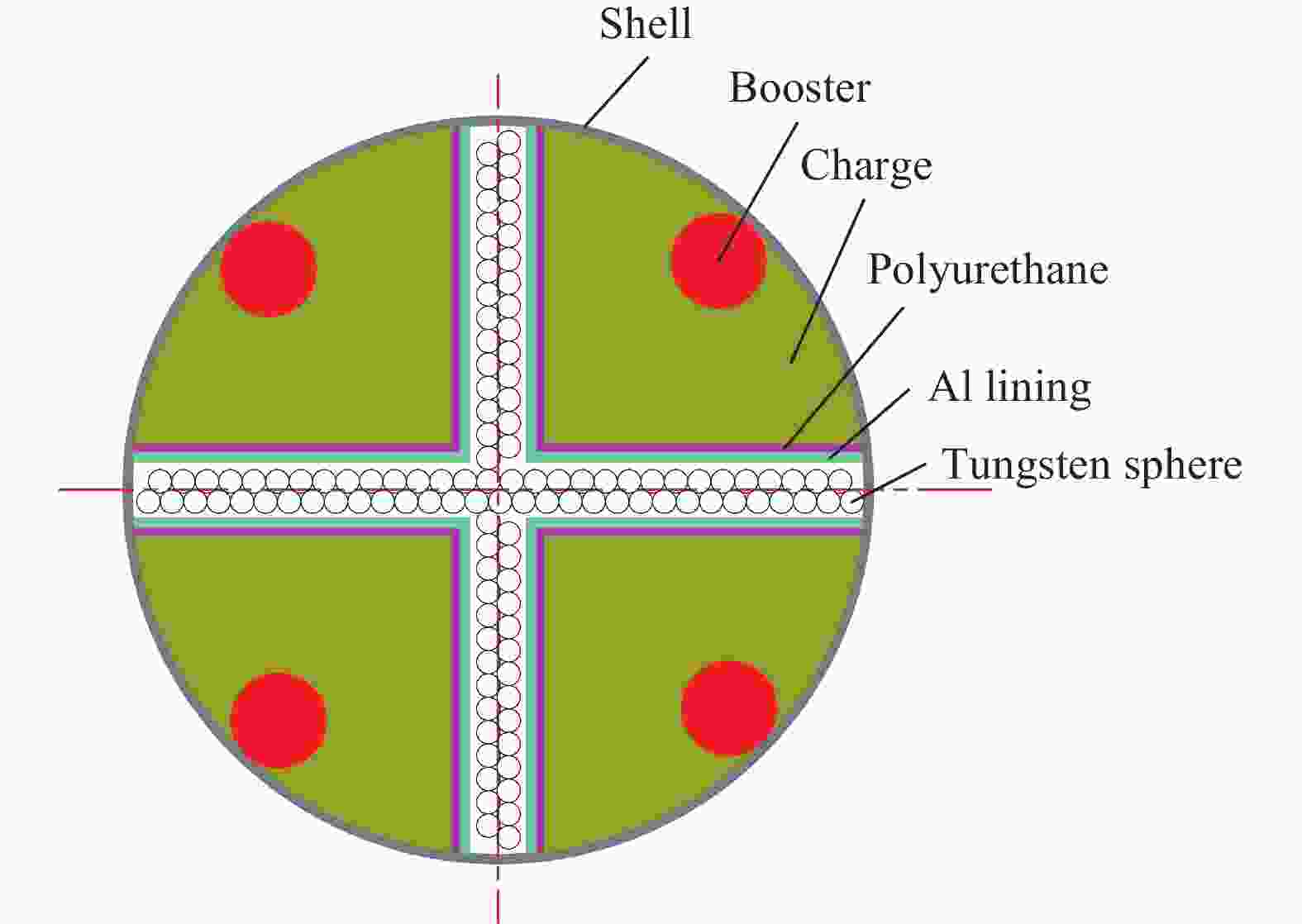
 下载:
下载:
